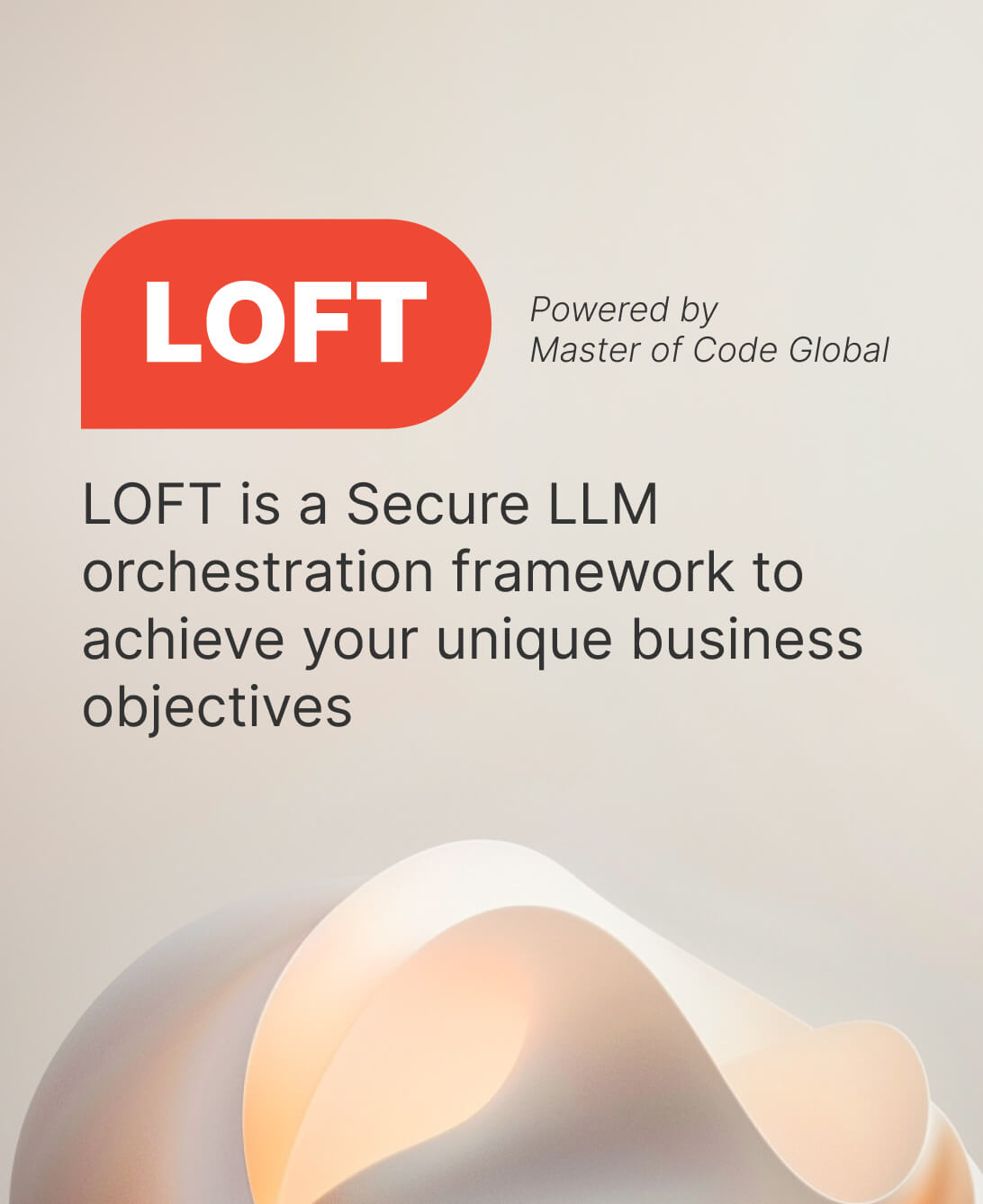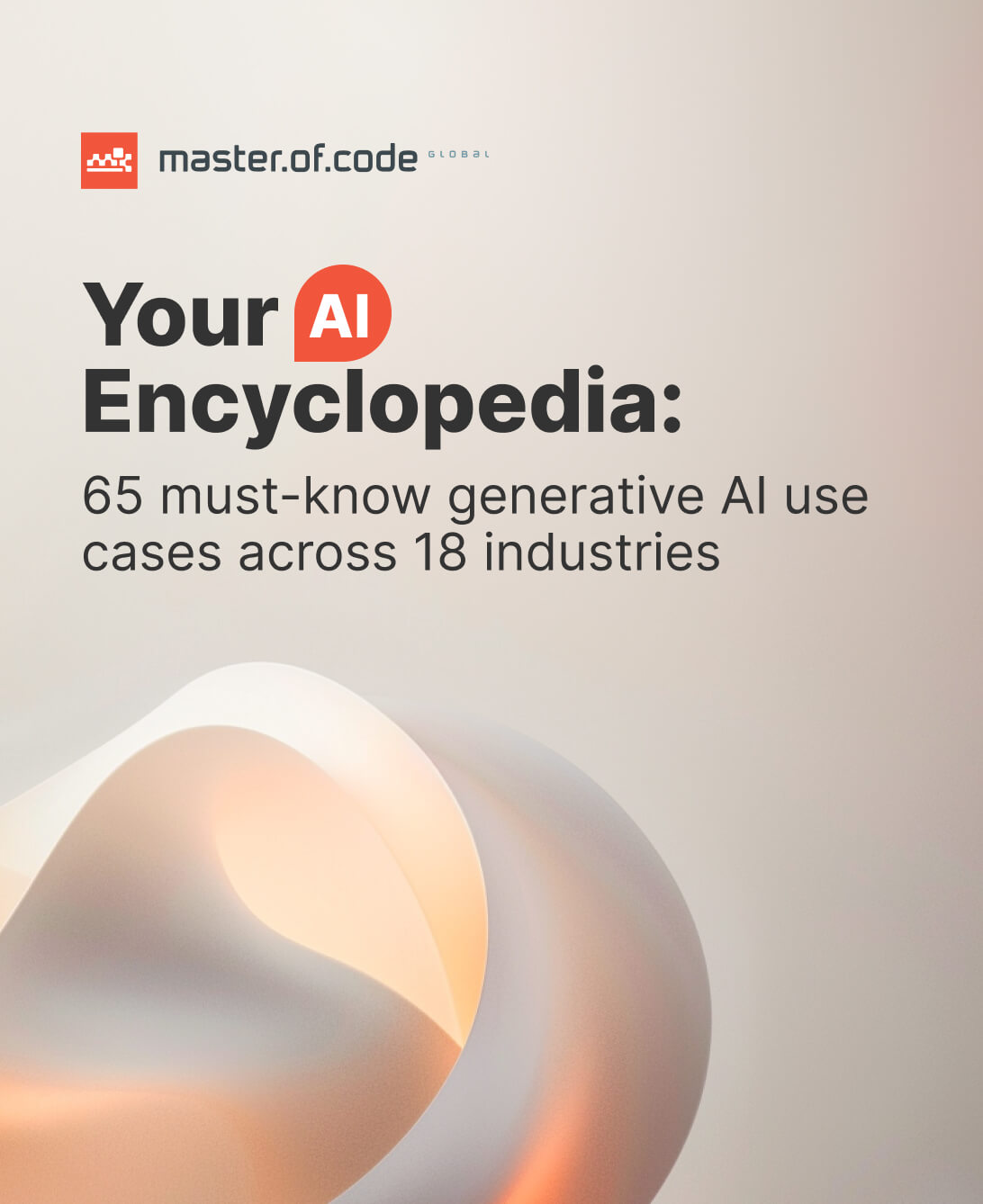New technology always raises questions: will it really help, or just add complexity? At Master of Code Global, we believe that knowing comes from doing. That’s why, to grow our expertise in Agentic AI development services further, we run pilots both internally and within our products. The tech is still new and has its quirks, so testing it firsthand helps us gain the kind of hard-earned lessons our clients value most.
One of those examples comes from our CTO, Bogdan Sergiienko, who shared the story of a recent experiment with a agentic AI copilot designed to support upsell funnels. The goal wasn’t to build a polished product, but to see how real users would actually interact with it. What we found was encouraging: people used the tool to set up funnels, explore options, and streamline their work. Even when they stepped in to make final adjustments manually, the pilot proved that automation could speed up routine steps and give users a clearer view of the process.
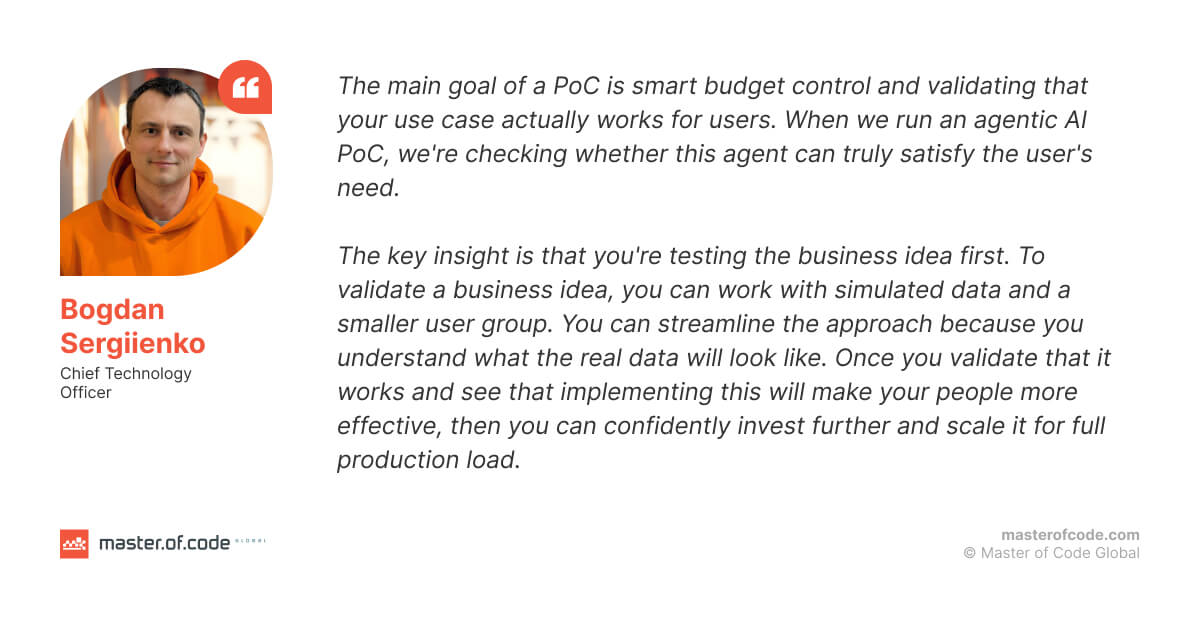
That’s exactly why Agentic AI PoCs are so important. They allow businesses to check not just if the technology works, but if it works for people in real conditions.
If you’ve never heard of a Proof of Concept or aren’t sure why it matters, stick with us. We’ll share practical insights from Bogdan Sergiienko and from our Head of Pre-Sales Strategy, Olga Hrom — both of whom know the ins and outs of AI PoCs — along with tips you won’t find anywhere else.
Table of Contents
What Is an Agentic AI PoC in Simple Terms?
Before we dive deep, let’s briefly explain what it’s all about. A proof of concept is a small-scale project that helps a company answer one key question: Will this technology work for us in practice? It’s not about building a polished product, but about testing feasibility and learning fast.
As our CTO, Bogdan Sergiienko, puts it:
“When we run an AI Agent PoC, the goal isn’t to make something production-ready. It’s to check whether the user’s real need can be satisfied by the agent. That tells us the true scope of what has to be built. We can simplify things, skip some of the heavy compliance or infrastructure work, and focus only on proving the business idea. If it works, then we know where to invest and how to scale.”
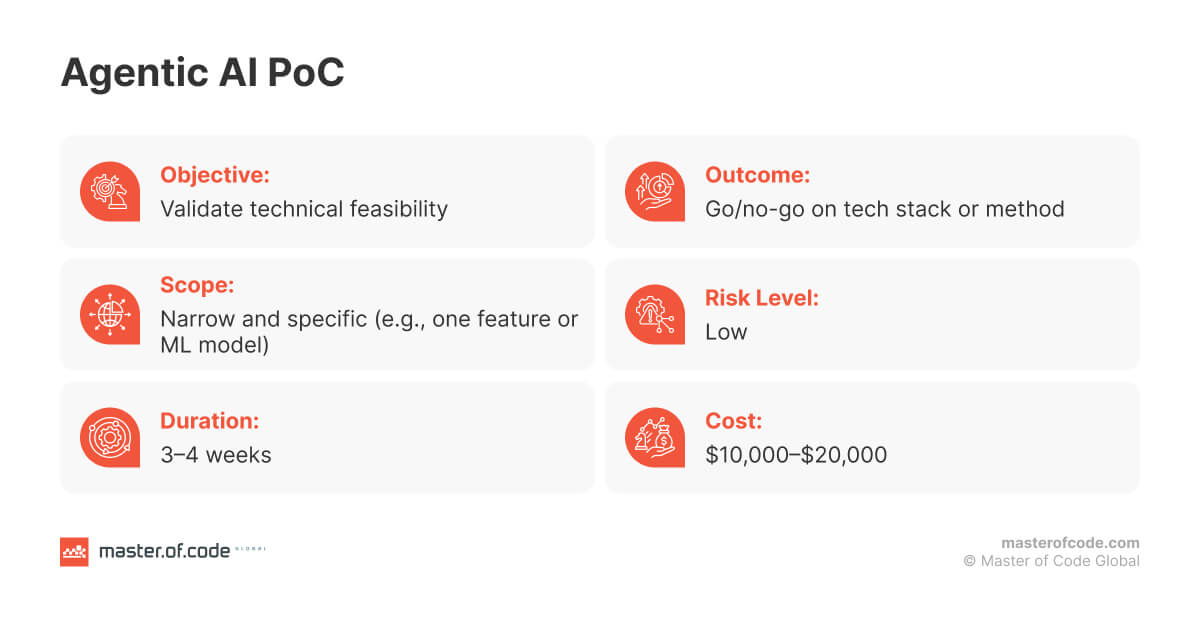
When you need an Agentic AI PoC
- When the use case is complex, uncertain, or has edge scenarios.
- When data quality, compliance, or infrastructure decisions could make or break success.
- When you want to validate impact and ROI before committing budget.
When you don’t
- For use cases that are already solved at scale.
- If resources are very limited and time is of the essence, building a rapid MVP or prototype can be more practical than running a test.
Why AI Agent PoC is worth it
- Identify the right tech stack early.
- Avoid wasting budget on the wrong direction.
- Unveil hidden bottlenecks or opportunities.
- Build stakeholder confidence with early wins.
That’s the quick overview; next, we’ll dig into how this technology actually works and what makes it unique.
What Is Agentic AI?
It refers to a type of artificial intelligence that doesn’t just respond to prompts – it acts. These systems can plan, decide, and carry out complex tasks on their own, with minimal human direction. They’re goal-driven, autonomous, and built to collaborate with tools and workflows like human assistants do.
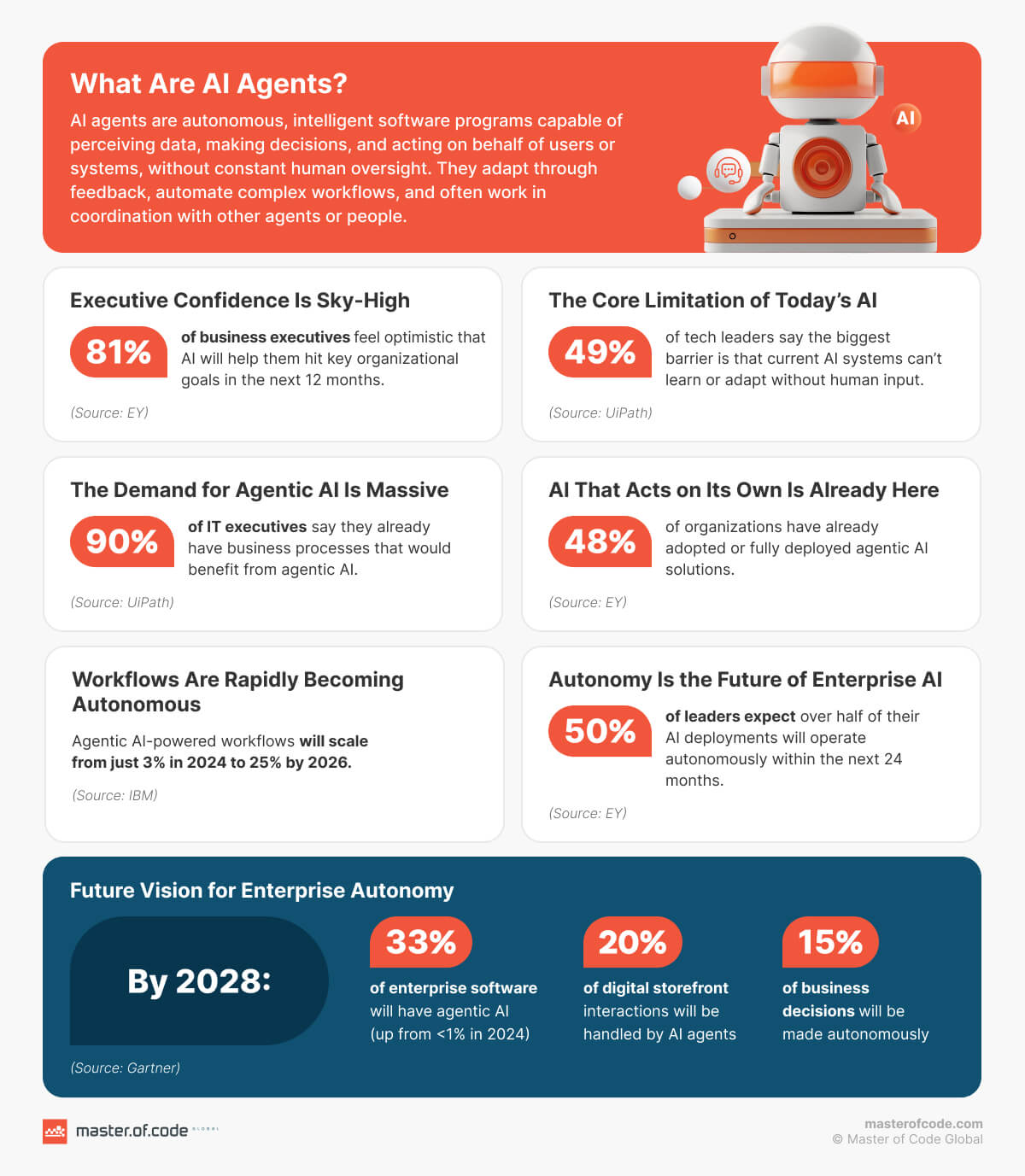
At its core:
- Agents are AI components designed to perform subtasks toward a bigger objective, working together through coordinated orchestration, as IBM explains.
- Unlike Generative AI, which responds only when prompted, agentic systems reason and self-direct; they perceive, strategize, act, then learn from results.
These capabilities make Agentic AI more than a step up from chatbots or generative models. It turns machine intelligence into autonomous problem solvers, able to handle multi-step operations and even adapt as situations change.
How It Works
It typically functions in a cycle of four key phases: Perceive → Reason → Act → Learn.
- Perceive. The system takes in data from its environment: APIs, user inputs, databases, or sensors.
- Reason. The agent breaks down the goal, plans steps, and decides on actions using logic or LLM reasoning.
- Act. It executes those actions by interacting with tools, software, or external systems.
- Learn. The algorithm absorbs feedback, adjusts its strategy, and improves its future output.
This loop allows Agentic AI to handle complex, evolving tasks and fine-tune its own performance over time. It’s something static intelligent frameworks can’t do. To make this concrete, let’s review six real implementations and the outcomes they achieved.
6 Real-World Examples of Agentic AI Systems
Agentic AI-Powered Data Discrepancy Reconciliation Tool
For a US energy leader, Master of Code Global built a standalone web app that surfaces inconsistencies between water and oil readings and explains them in plain language. The agent flags issues, suggests likely causes, and helps teams resolve them faster.
Results
- Reduced manual reconciliation effort through automated detection and explanations.
- Clearer visibility into issues via a visual dashboard and role-based access.
- More reliable reporting by minimizing human error in the process.
Agentic AI-Powered Revenue Engine
For a B2B lending provider, we unified fragmented performance data into a single analytics layer and embedded an assistant that monitors marketing ROI. Teams can ask questions in natural language, spot anomalies, and reallocate spend with confidence.
Results
If ROI is your next step, start here: How does AI reduce costs – detailed scenarios, hard metrics, and lessons learned.
Zipify Agent Assist Case Study
A fast-growing eCommerce company needed to scale support without sacrificing quality, so we delivered an internal assistant and analytics dashboard inside Intercom. The solution accelerates answers, builds help content automatically, and tracks team performance.
Results
- Greater operational efficiency for support workflows.
- Continuous growth of a structured knowledge base.
- Higher agent engagement with real-time insights and leaderboards.
- Lower workload on repetitive queries and improved customer satisfaction.
Siemens – Predictive Maintenance Agents
A global industrial player uses agentic systems to anticipate equipment issues and trigger proactive service, improving availability and cost efficiency. Reported outcomes include lower maintenance expenses and better uptime across operations.
Mayo Clinic – Radiology Assistant
In clinical imaging, agentic software helps clinicians generate structured reports faster while maintaining diagnostic quality. The approach improves reporting times and assessment accuracy for healthcare professionals.
JPMorgan Chase – Risk Monitoring Agent
Within banking, autonomous monitors track exposures in real time and estimate the likelihood of default to strengthen portfolio oversight. These capabilities support more responsive risk management.
Advantages and Risks of Agentic AI
The examples above show how this technology can deliver real outcomes across industries. To understand its full capabilities, it helps to weigh not only the clear benefits but also the unique risks that come with giving a machine more autonomy.
Key Advantages
- Goal-driven execution – unlike standard AI, agents don’t just answer questions; they pursue objectives, breaking them into steps and carrying them out.
- Dynamic orchestration – multiple solutions can coordinate tasks, passing context and results between each other to handle end-to-end workflows.
- Faster adaptation to change – because agents can re-plan when conditions shift, they’re well-suited for environments where data and priorities evolve quickly.
- Human-like collaboration – natural language interfaces mean teams can guide complex systems as if they were working with a colleague, not coding a tool.
- Redefining processes – introducing this tech often forces companies to rethink how work gets done, exposing inefficiencies and opportunities for entirely new approaches.
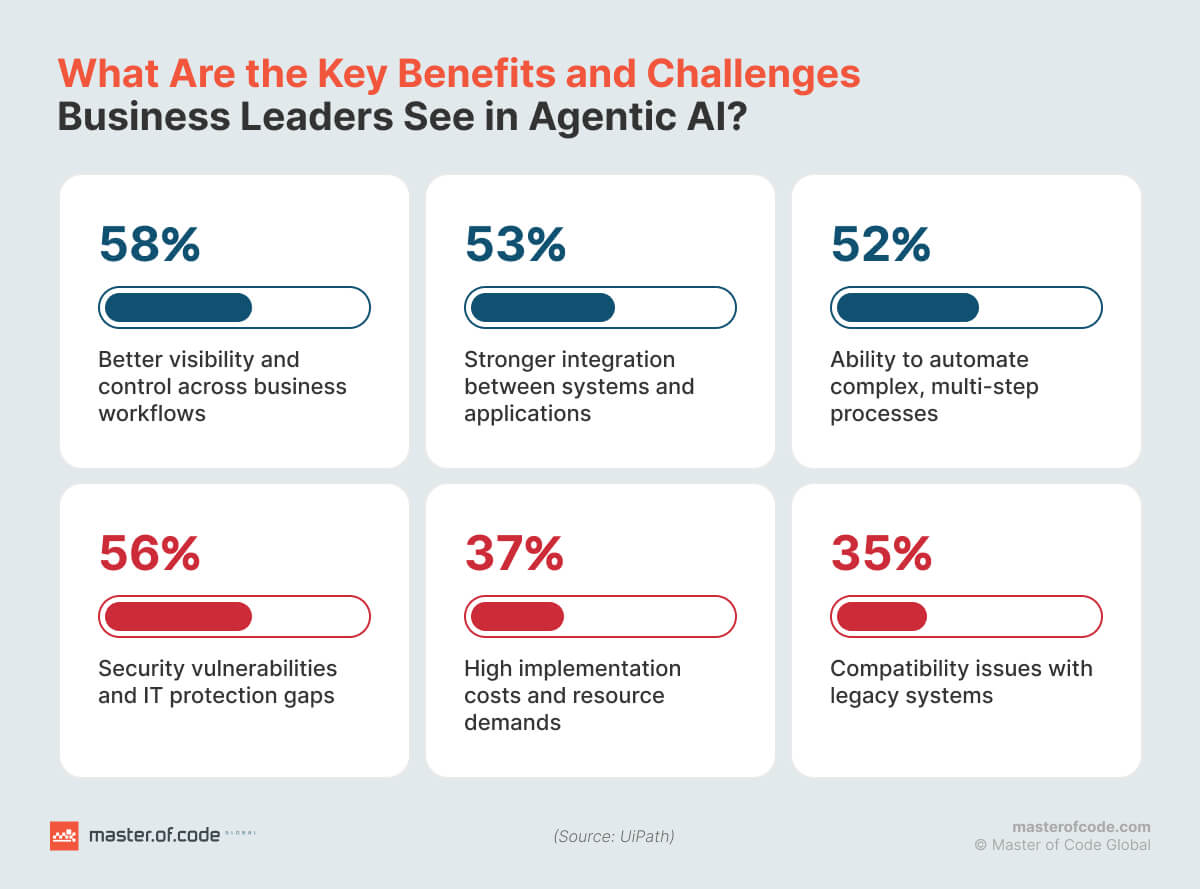
Common Risks and Challenges
- Loss of control – autonomy creates uncertainty if guardrails aren’t strong enough to keep agents aligned with business aims.
- Expanded attack surface – the very features that make these systems powerful (like tool use, integrations, and agent-to-agent communication) also open new security gaps.
- Hidden compliance gaps – in regulated sectors, agents may act faster than governance processes can keep up, leading to unexpected violations.
- Overestimated reliability – unlike traditional software, agentic AI may not deliver 100% accuracy out of the box, and unrealistic expectations can derail projects.
- Organizational misalignment – many companies aren’t structurally ready for the shift in accountability and oversight that autonomous systems require.
Agentic AI is proving its value across industries, but its autonomy also raises new challenges that enterprises can’t ignore. The logical next step is figuring out how to implement AI in business in a controlled, low-risk way.
That’s exactly where Proof of Concept comes in — giving companies a safe space to test assumptions, measure outcomes, and decide whether to scale.
Why Run an AI Agent PoC?
Artificial intelligence is advancing quickly, and PwC highlights a clear divide between early adopters and those who wait. Organizations that experiment now are not just testing technology. They are defining their capability roadmaps and building institutional knowledge that late movers will struggle to catch up with.
Why being early matters:
- First-mover advantage – setting benchmarks in their industries before standards harden.
- Faster learning curve – cultivating AI literacy and internal talent ahead of competitors.
- Shaping regulation and ecosystems – influencing compliance practices, partnerships, and tool choices.
- Better investment planning – exposing real AI development cost and ROI potential, enabling leaders to allocate budgets wisely.
This is where the AI agent PoC becomes essential. It gives companies the chance to move fast without losing control – validating use cases early, postponing non-critical work, and learning what really matters before scaling. In practice, that means you can act like an early adopter, capture the benefits of moving first, and still avoid many of the costly mistakes they make.
As our CTO, Bogdan Sergiienko, explains:
When we run an agentic AI PoC, we deliberately limit overall scope. Some things can be done in a simplified way and finalized later, only when we know production is needed with real users and real data. We check first against business goals – does this work or not? If it does, planning the rest of the budget becomes much easier. Even for security, we lay the right architecture, but avoid pushing sensitive data through at the start. That way, we save time, test safely in a ‘playground,’ and only invest in full compliance and scaling once we know the solution works.
From a pre-sales perspective, Olga Hrom emphasizes that the uncertainty around artificial intelligence makes structured testing critical:
For AI projects, it is really hard to predict how impactful and accurate a solution might be. From both financial and business perspectives, it is always better to invest in a smaller project, check the analytics, the ROI, the business outcome, and then scale.
Running an AI agent PoC gives organizations three key advantages:
- Strategic clarity – align initiatives with measurable objectives instead of chasing hype.
- Controlled risk – experiment in a safe, limited scope before committing significant investment.
- Stronger adoption – build stakeholder trust with tangible evidence that the application can work in real conditions.
Put simply, this approach bridges vision and execution. It helps leadership decide whether an agentic solution should stay a concept on paper or become a core part of the strategy.
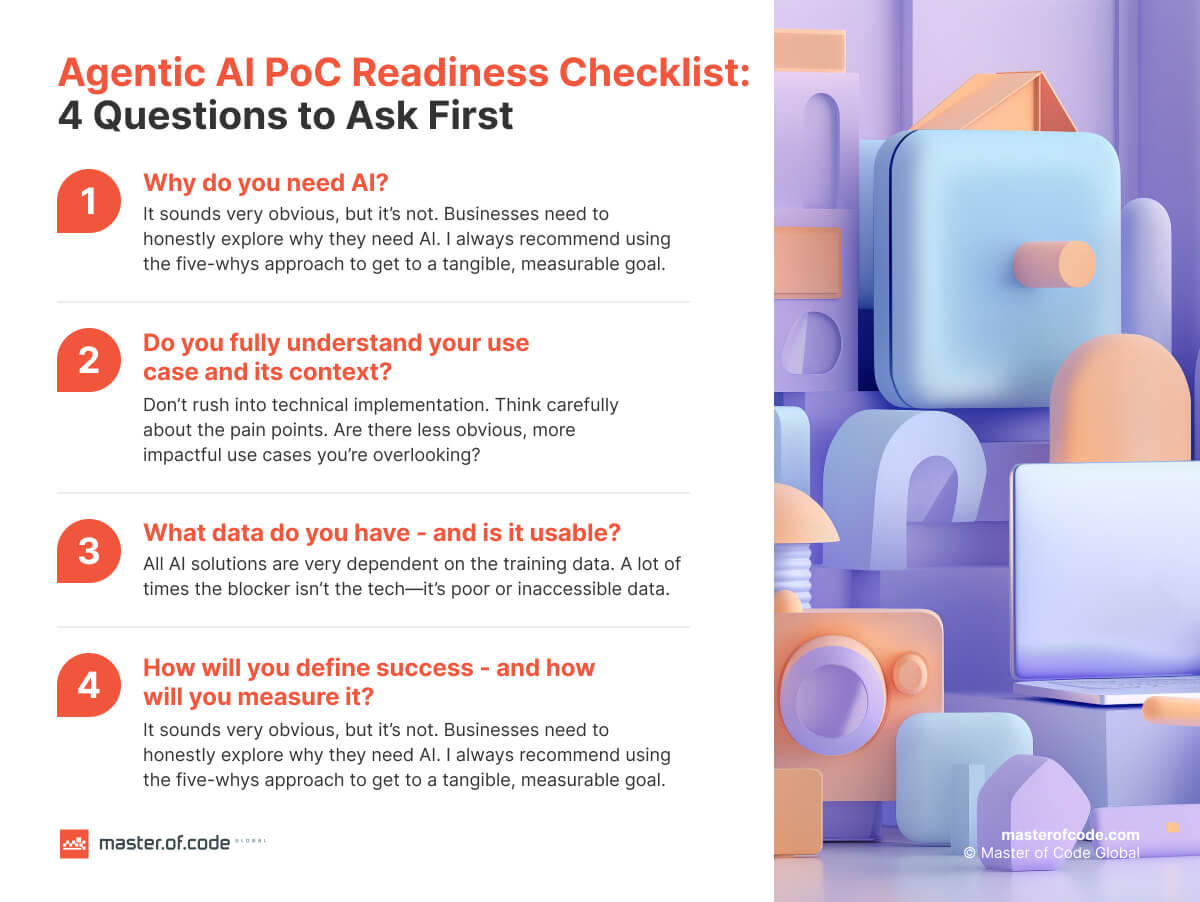
What Makes a Successful AI Agent PoC?
A proof of concept succeeds when it does more than prove the technology works. It should give leadership a clear view of whether the solution can solve a real business need, how it fits into long-term strategy, and what it will take to scale. It’s like crafting a roadmap – aligning experimentation with both immediate use cases and future plans.
Core Components of a Strong Agentic AI PoC
1. Clear business goals
Every PoC should begin with tangible success metrics. As Olga Hrom explained: “There are many projects where the technical solution is solid, but stakeholders still consider it unsuccessful because success criteria were never defined. It’s not enough for something to work technically. The business side needs to agree upfront on how success will be measured.”
At Master of Code Global, we start with discovery workshops and use the “five whys” approach to drill into the real drivers – whether it’s cost savings, revenue growth, or improved customer experience.
2. Scoped experimentation
An AI agent PoC should remain lightweight, testing only what matters most. In practice, this often means simulating data, limiting integrations, or building only the minimum flows required to validate the idea.
As Bogdan Sergiienko noted, “In one prototype we built, the client is now preparing to test it with a small group of users. With their feedback and necessary adjustments, only then will they move on to production for the wider audience. That’s exactly the purpose of an Agentic AI PoC – to learn early, adapt, and scale with confidence.”
3. Data readiness
Without quality data, even the smartest model will fail. Olga Hrom pointed out: “The main blocker for solution effectiveness is not usually the technical stack. We have strong LLMs and third-party tools, but if data is scattered, poorly structured, or not compliant, the solution cannot show results.”
That’s why we run early data audits – checking accessibility, structure, and permissions – to prevent bottlenecks later.
4. Adoption planning
AI roadmaps are as much about people as technology. “Releasing the solution is not the end – it’s just the beginning,” – Olga Hrom states. “If employees don’t use it, it’s not because the solution is bad. Sometimes there are too many tools or change fatigue. The business must plan for onboarding and adoption as part of success.”
At Master of Code Global, we support this through rollout materials, knowledge transfer, and success management so that both internal teams and end-users engage with the solution.
5. Iteration and learning
A PoC should reveal more than the obvious. As Olga Hrom highlighted: “Sometimes the pain you think you have isn’t the real one. The Agentic AI PoC helps uncover hidden bottlenecks or opportunities you didn’t see at the start. That’s where real value can appear.”
We structure proof of concepts as cycles – test, analyze, adapt – so every round uncovers insights and sharpens the business case.
Why This Matters
Too many companies treat an AI agent PoC as a quick demo. In reality, it should be the foundation for a broader intelligentization strategy – the bridge between discovery and delivery. A well-run test saves time and resources, prevents overbuilding, and accelerates the path to scale by making costs and requirements predictable.
As Bogdan Sergiienko put it: “You need to plan carefully where the agentic approach makes sense and where another method is better. Otherwise, expectations will be unrealistic and results disappointing.”
Olga Hrom added, “For AI projects, it is really hard to predict how impactful and accurate a solution might be. That’s why it’s always better to invest in a smaller project first – check the analytics, the ROI, the business outcome – and then scale.”
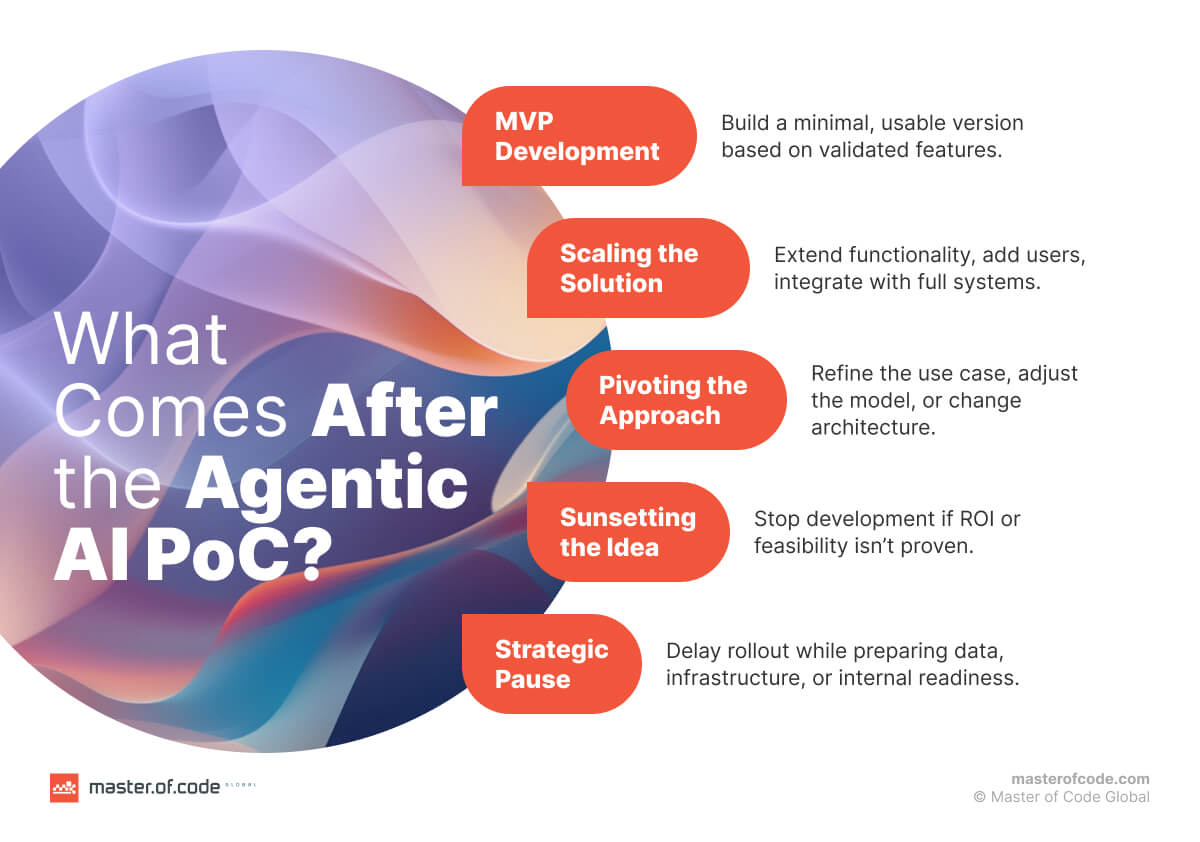
Let’s Make AI Agent PoCs Work for You
A proof of concept is one of the safest, smartest ways to explore agentic technology, but only if it’s approached with discipline. Based on lessons we at Master of Code Global have learned so far, here are the essentials on AI implementation in business:
5 Do’s
- Define success upfront – agree on clear, measurable KPIs so everyone knows what “good” looks like.
- Start small, learn fast – keep scope narrow to validate the idea before investing further.
- Audit your data early – ensure accessibility, structure, and compliance before building.
- Engage stakeholders – bring business and technical teams together to align expectations.
- Plan for scale – treat the Agentic AI PoC as a stepping stone, not a dead end.
5 Don’ts
- Don’t overload scope – trying to prove too much at once leads to confusion and wasted budget.
- Don’t ignore adoption – user onboarding and change management matter as much as tech.
- Don’t chase hype – avoid running an AI agent PoC just because it is trending; focus on business needs.
- Don’t skip guardrails – even in a sandbox, design the right architecture and basic security.
- Don’t forget ROI – always link outcomes back to cost savings, revenue, or efficiency gains.
And remember: you are not alone in your artificial intelligence integration journey. You can sidestep common mistakes and losses with our help. At Master of Code Global, we treat every Agentic AI PoC as the launchpad for long-term adoption, combining structured delivery with flexibility to adapt as we learn.
Here’s how we do it:
- Discovery & Scoping – define goals, use cases, and success criteria.
- Data Preparation – audit and structure data sources for AI readiness.
- Prototype Build – create a lightweight version that tests the core idea.
- Sandbox Testing – run pilots with limited users and safe environments.
- Evaluation – measure results against business and technical KPIs.
- Roadmap Definition – refine the scope, budget, and plan for scaling.
This framework is backed by 10+ years of delivering AI-powered experience and over 1,000 successful projects across finance, healthcare, retail, and telecom. It is why 90% of our discovery engagements convert into full-scale development, and why companies trust us to turn their experiments into enterprise-grade solutions.
If you are still hesitant, let’s have a quick call with Olga Hrom. She will help you clarify goals, identify blockers, and outline a practical Agentic AI PoC plan tailored to your business.

